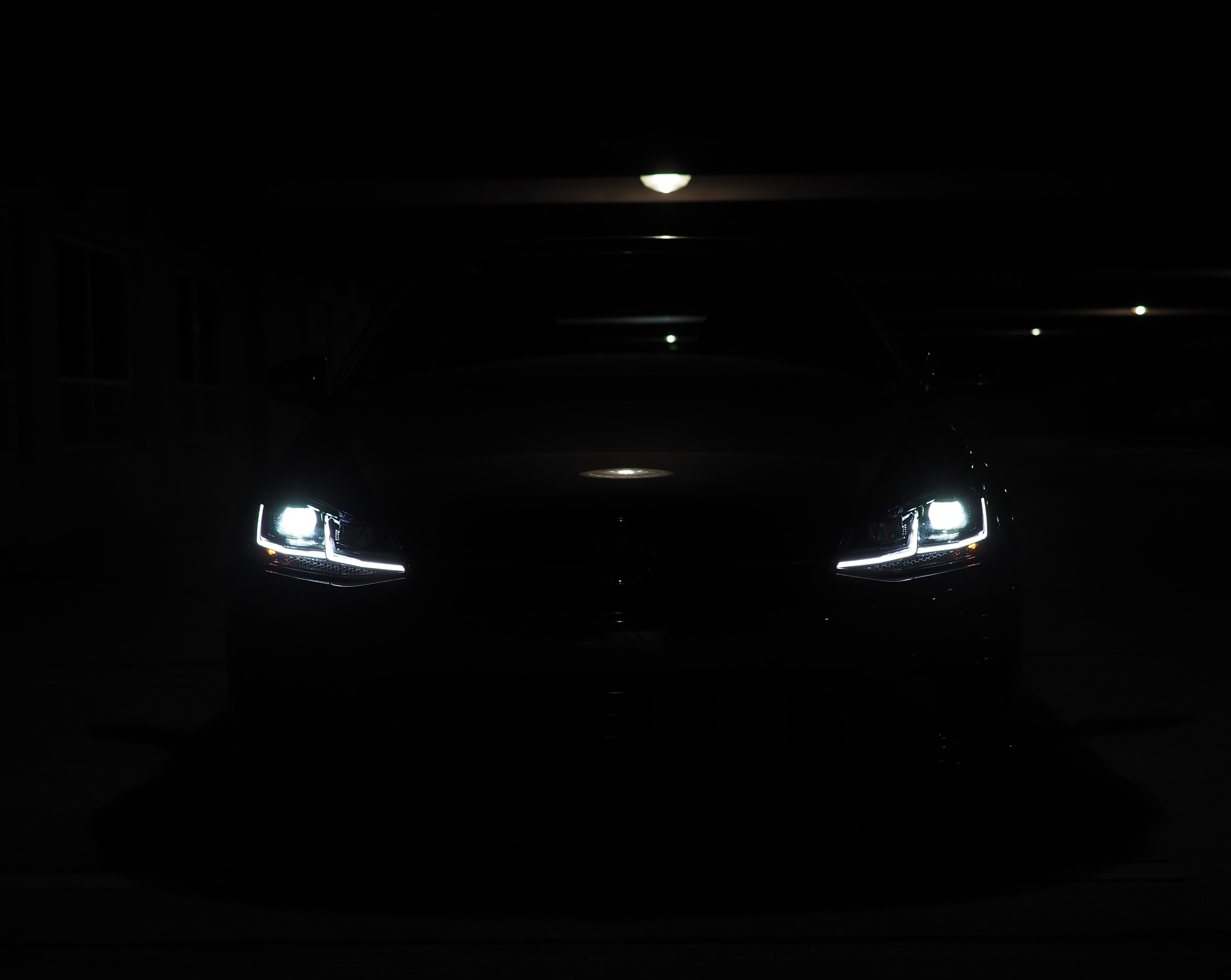
I have a problem.
My car is constantly in the shop. Since purchasing my 2011 BMW 335i xDrive in 2012, we’ve put around $10,000 worth of repairs into it. That is not a typo. Additionally, BMW has foot the bill for another ~$5,000. A total of roughly $15,000 spent in repairs in my six years of ownership; my time with the car started less than two years into the car’s life.
I love my car… when it works. But with each passing mile, my confidence in it wanes. Mechanics can fix the car; no mechanic is good enough to repair my confidence. It’s time for something new.
On paper, what I want is another BMW: a 340i or M3. But I look at the price tag, and I realize it’s more than I can afford. Even if I could afford it, I can’t bring myself to try another BMW. I need a break, and my confidence needs to rebuild.
So what do I do?
I want something that’s three pedals, four doors, reasonably nice, reasonably fast.
Options:
- Audi A4
Possibly a bit too slow; definitely a bit too expensive. - Civic Type R
I’m not sixteen. - Ford Focus ST
I’m not twenty one. - Ford Focus RS
I’m not eighteen. - Honda Accord
I’m not forty. - Volkwagen GTI
A smidge too slow.
However, Volkswagen has an ace in the hole.
Enter the Volkwagen Golf R.
Video
As with all Casey on Cars reviews, I have filmed and produced a video about the Golf R. I’d really appreciate it if you could watch it, throw it a 👍, and even subscribe to my YouTube channel. I still have plenty of ways to grow as a YouTuber and car reviewer, and I already have plans I’m really excited about for the next edition of Casey on Cars.
More and Liss Less
The Golf R is, on the surface, little more than a GTI cranked to 11. However, upon closer inspection, it’s quite a lot more than that… while also being less than that.
The Golf R is the latest in a line of cars that began with the R32 in the early aughts[1]. The most hot-roddy of all the hot-rod editions of the Golf, it is Volkswagen’s offering as the pinnacle of performance in a utilitarian body. The hottest of Volkswagen’s hot hatches. (Though interestingly, Volkswagen’s web site presents the GTI as a hot hatch and the R as a performance hatch.)

At a glance, there are a few major changes from the GTI. The Golf R:
- Has a Haldex all wheel drive system
- Has more power:
- Horsepower is bumped from 220 → 292, a ∆ of 72 HP
- Torque is bumped from 258 → 280, a ∆ of 22 lbft
- Is made in Germany (the GTI is actually assembled in Mexico)
- Has Volkswagen’s new “Digital Cockpit” instead of traditional analog gauges.
- Has an electronic parking brake
However, not everything is a victory. The Golf R:
- Lacks a sunroof
- Cannot park itself
- Is a shade under $5,000 more than a loaded GTI
So, which is the one to buy?
I got to spend a full week with the Golf R, just a couple weeks after I spent about 20 minutes with a former colleague’s GTI. Though I’d love a lot more time with the GTI for a proper comparison, I spent enough time with the GTI to get the gist.
Exterior
The Golf R is very quiet about the fact that it’s the fastest of all the Golfs.
There is only one R badge for each side of the car. In fact, the most
ostentatious part of the car is probably the quad exhausts in the rear. Despite
being both visually and aurally loud, I quite like them.

Things are not all perfect, however.
Those wheels. What is going on with those wheels?
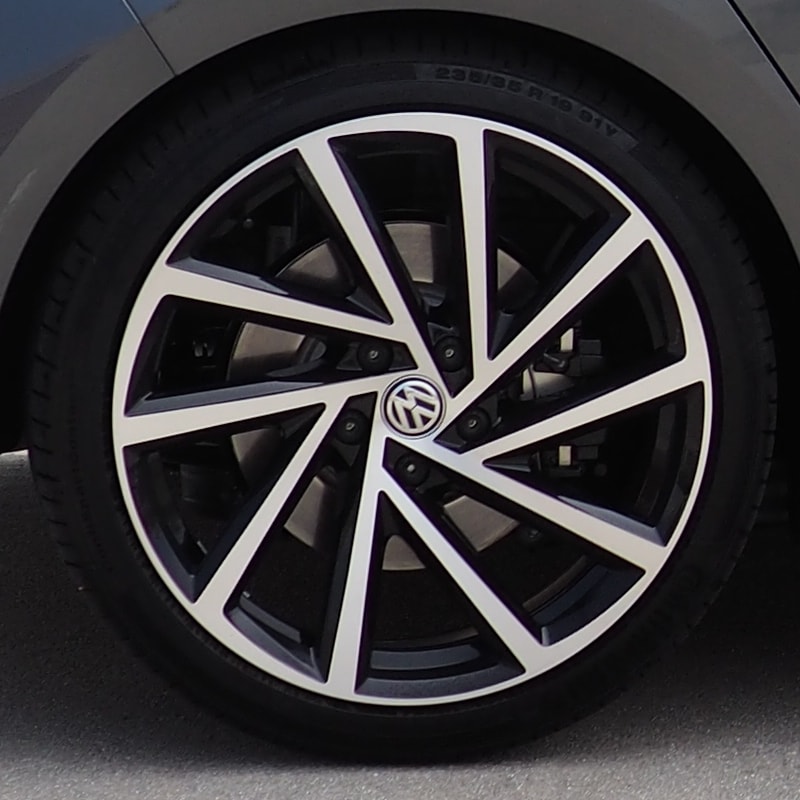
Known as “Spielberg” or “Englishtown” wheels, I really dislike them. Furthermore, adding insult to injury, I loved the 2017 Golf R’s “Pretoria” wheels:
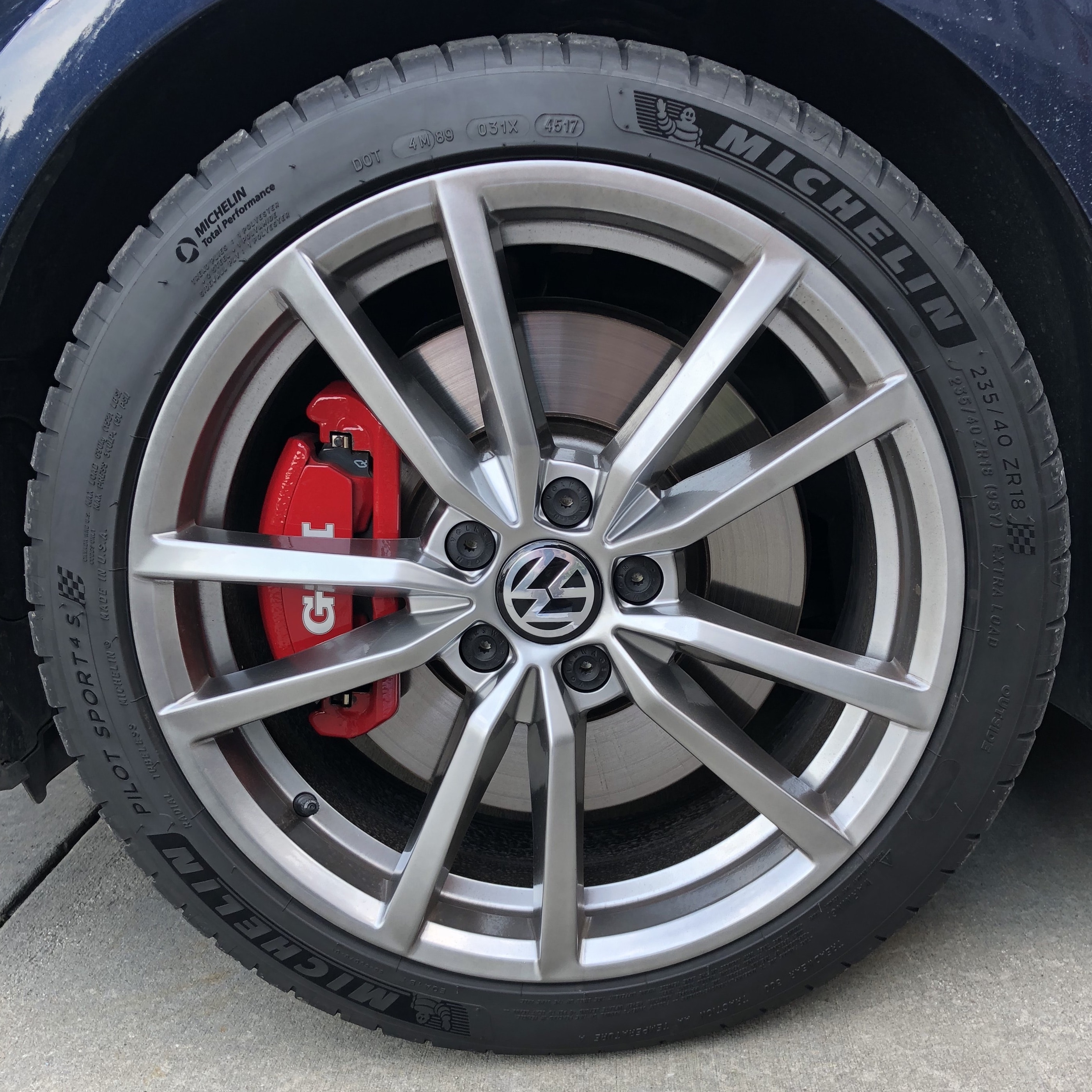
I know wheels are an easy thing to change, but Volkswagen, your wheels. Woof.
Interior
The interior of the Golf R is a fine place to be. It does not feel like a Volkwagen to me, but rather, more like an Audi. In fact, I spent a very very short amount of time in a brand-new A4 this past weekend, and in many ways I think the Volkwagen was laid out more logically, while feeling no cheaper than the Audi.
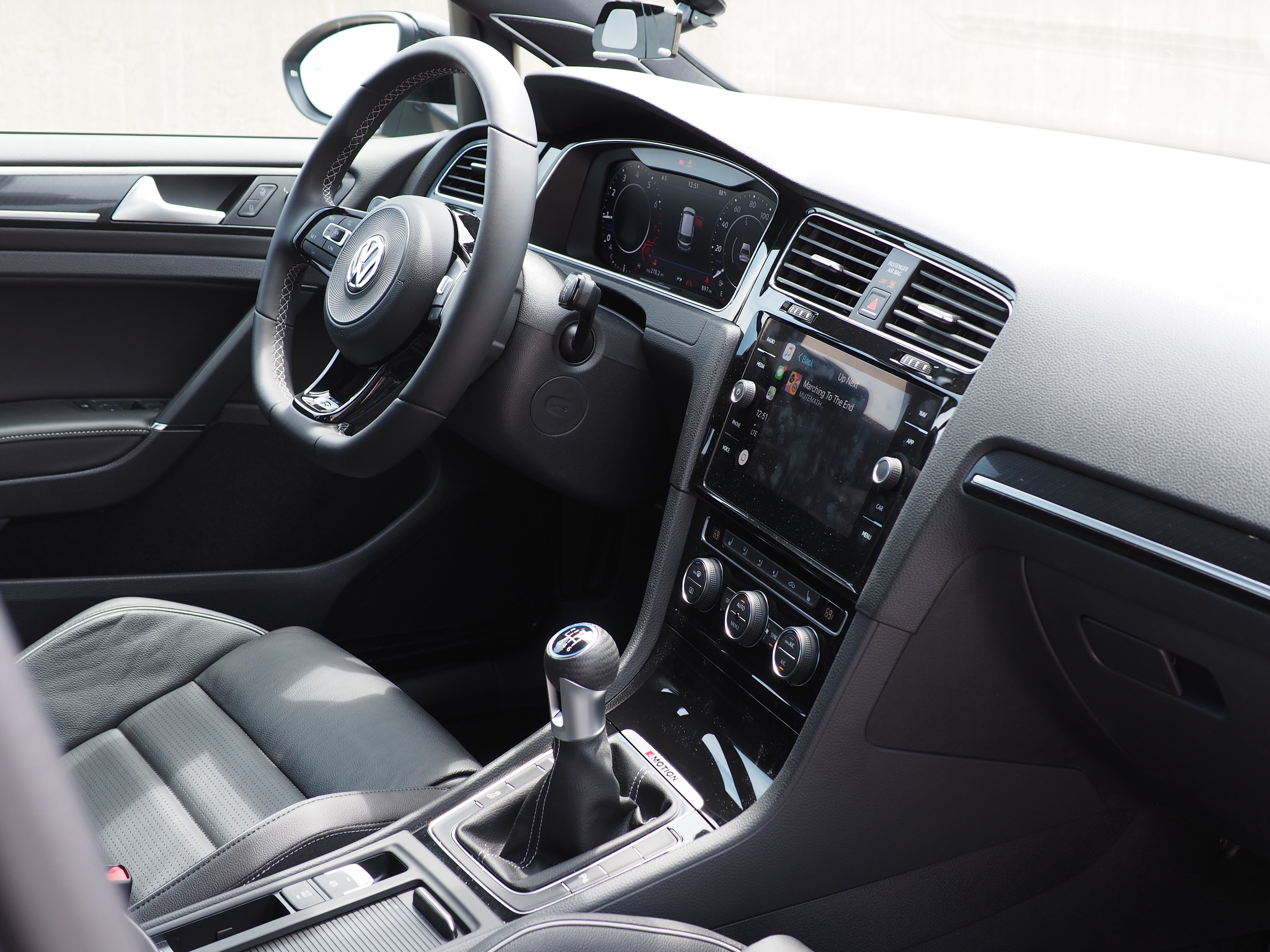
The seats are comfortable and the side bolstering in the front is more than sufficient. Quite oddly, however, the driver’s seat was 100% electric, but the passenger seat was almost entirely manual. Only the seatback’s tilt was electric. It was a very peculiar choice; I almost feel like for consistency’s sake, the tilt should have been manual too. Nevertheless, the rear has ample legroom; I was surprisingly comfortable in the back, and didn’t long for more space.
All the way in back, things were hit and miss. The Golf is a hatchback, and as such, the opening to the trunk is massive. However, there is almost no depth to the trunk; it is far shallower than my BMW. Quite obviously, it is considerably taller than my BMW’s trunk, but given the choice, I prefer my volume by way of increased “surface area” rather than height.
With the rear seats folded down, the Golf is cavernous. However, it’s unsurprisingly impossible to fold the seats down when you have two small children, each of whom comes with one large car seat. Thus, for me, today, the trunk is far smaller than I’d prefer, unless I’m willing to stack things on top of each other.
Back in the driver’s seat, I could make an argument that the Digital Cockpit is a mistake, as it will look dated in a few years. Be that as it may, the flexibility of the dash makes me think it’s the right answer. Being able to see a map of where the navigation is directing you right in between your speedometer and tachometer is pretty great. Furthermore, the configurability of the Digital Cockpit is enough to keep me busy for quite some time. I count it as a win.
Curiously, the R also exposes its heritage as an affordable car. Most European cars equipped with an automatic transmission have a “kickdown” switch. When you floor the car, and then press the pedal just a bit further, the car takes that as “GIVE ME ALL SHE’S GOT”. It will downshift as much as possible, in addition to the car already being floored. The Golf R I drove had a kickdown switch. The manual Golf R I drove… had a kickdown switch. Which does absolutely nothing. Apparently the Volkswagen parts bin had it on special!
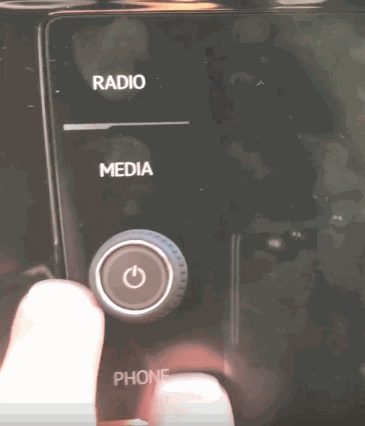
The GTI and R alike also suffer from a fatal flaw: the volume and on/off button for the infotainment. The button has a standard power icon on it, which makes perfect sense. However, that power icon twists when you adjust the volume. As someone who is, shall we say, a touch anal-retentive, this is infuriating. The problem is fixed by only adjusting the volume via the steering wheel controls, but, hoo boy, it’s annoying.
The Golf does have lane keeping aids and automated cruise control, but it doesn’t have full-on automated piloting, which is too bad. The controls for all of these automated driving aids are pretty straightforward. The lane keeping, left to its own devices, will basically ping-pong between the edges of the lane, but it’s not comparable to true automated driving systems like the one on Erin’s XC90.
The Golf does best the Volvo on the way it displays your desired versus actual speed when using cruise control. When in Erin’s car, I often find myself camping in the slow lane for a while, going well under the speed limit, because it’s not entirely obvious that the car has slowed under my desired speed due to traffic. In the Golf R, it helpfully has a thick red bar to indicate the car has slowed below its cruise setting; it shows a thick green bar if you manually accelerate over the cruise setting.
The infotainment is good, but largely unremarkable. The same goes for the navigation. One could argue “unremarkable” is the mark of a successful implementation — a system that doesn’t get in the way is in many ways a great system. Additionally, the infotainment supports both CarPlay and Android Auto, which I consider to be requisite on any car I will buy in the future.
Driving
The Golf R shines on the road. The interior may be confused as to whether the Golf R is a luxury car or not. The driving experience removes all doubt about how it behaves on the road: this is a performance car.
It took me almost no time to fall in love with how the Golf R feels.
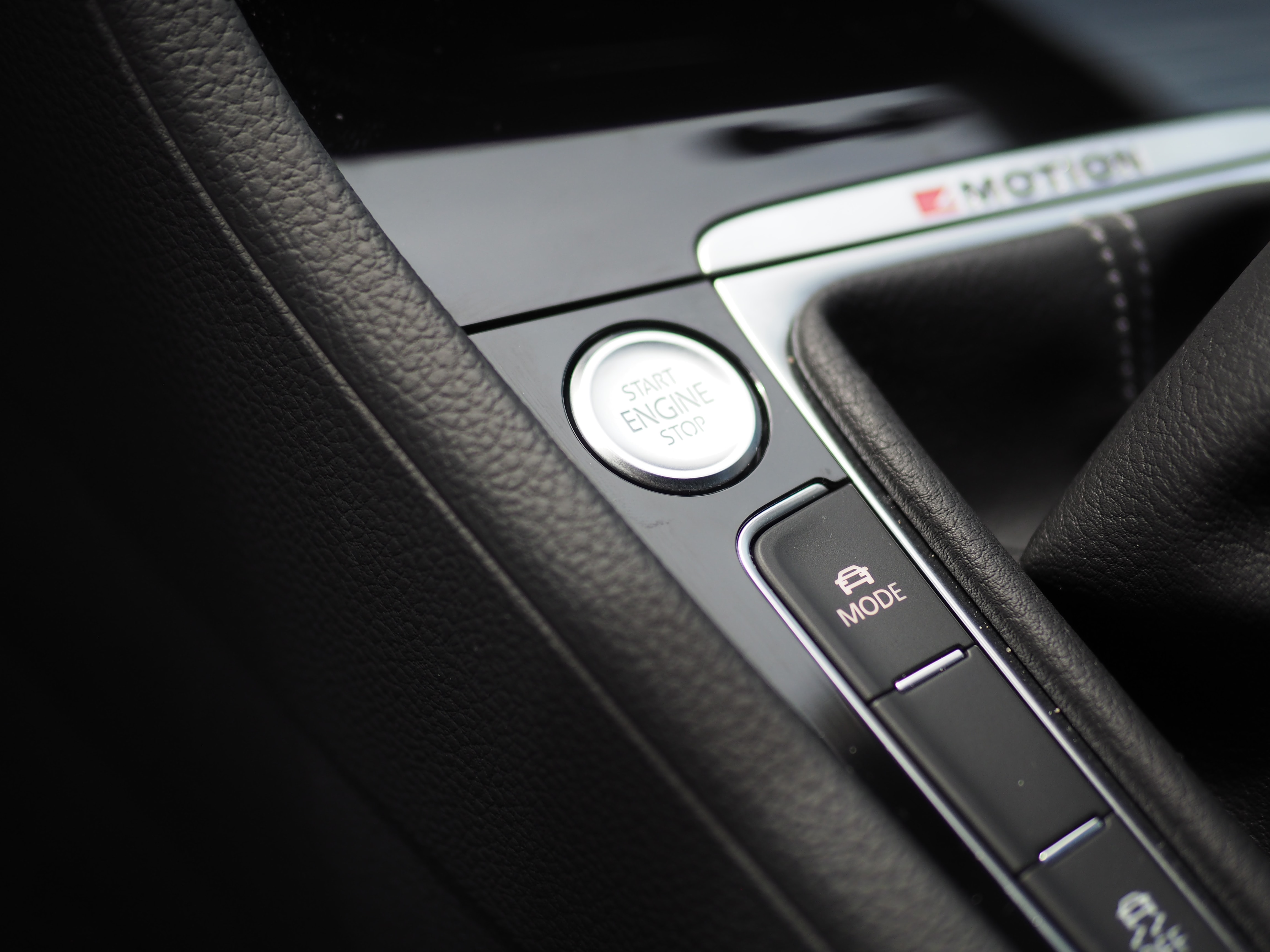
My love of the R began the first time I took off from a stop. I’ve driven a stick since I got my license 20 years ago. Every time I drive a new-to-me car that has a standard transmission, it takes me a couple hours/days/weeks to really get the feel for that car’s clutch. With the R, I felt like I had already driven the car for weeks.
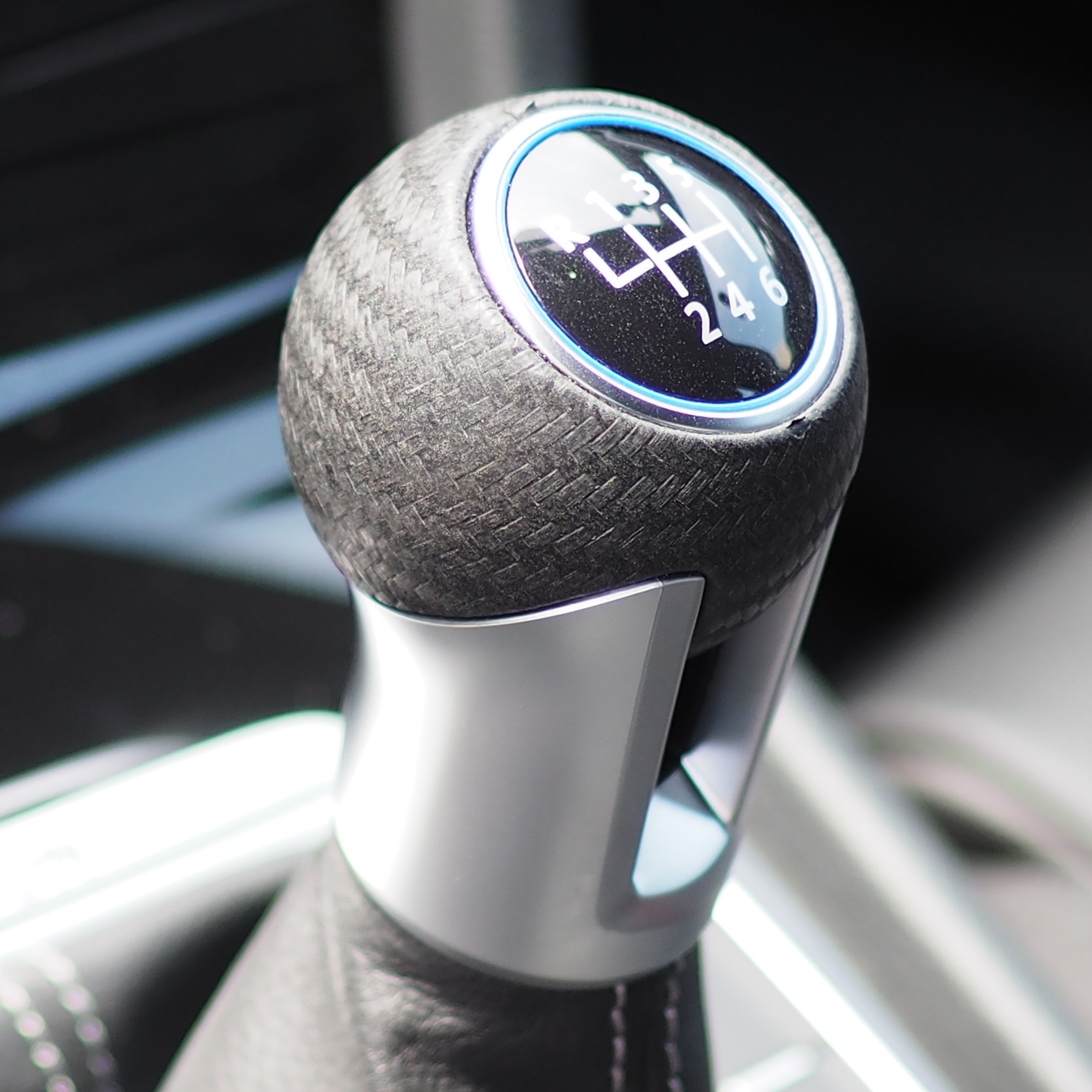
The gearshift was also interesting. The feel in the hand was okay but not great; the knob felt a bit like a golf ball, which I can’t say I loved. Unlike almost all other cars with a front-mounted transmission I’ve driven, the shift linkage felt really good. It was way crisper and more notchy than I expected. There was one small curiosity about it, though: the lateral distance between gears — 1st and 3rd / 3rd and 5th / 2nd and 4th / 4th and 6th — was very small. It was by no means a problem, but it was something I noticed every time I drove the car.
All that said, even if the shift linkage was garbage, and even if the clutch was difficult, I’m still thankful that Volkwagen even offers a stick. I know that my time is running out with three-pedal cars, and I’m glad I don’t have to give up on my dream yet.
When treated with a gentle foot, the Golf R is true to its humble economy car roots. It’s docile, reasonably quiet, and not too twitchy. The suspension is rougher than I appreciate; however, that’s par for the course when it comes to a performance car. The suspension is adjustable — and I did adjust it — but I never found it to be quite as compliant as I’d like.
Once you give the Golf R some throttle, or switch the drive mode from Eco or
Normal to Race, or perhaps Custom[2], everything changes.
The Golf R is one of the best point-and-shoot cars I’ve ever driven. Perhaps the best. Even with my preferred but very-driver-involved transmission, the R goes where you ask it to. No matter how much throttle you give it. No matter what steering angle. No matter what speed. The Golf R figures it out.
In essence, the R looks at the laws of physics, thinks for a moment, and then comes to a conclusion: “No, thank you.”
I took turns that were entirely too sharp, with entirely too much speed, giving the car entirely too much throttle, and there was no drama. Every single time. The R just ate it all up.
It was intoxicating.
In a straight line, the R is very fast; it will hit 60 MPH in just barely over 5 seconds with a skilled driver. The dual-clutch R, with its launch control, can do it in just under 5 seconds. All this in a car that can haul five people… and a dresser.
The only complaint I have is that the car definitely has turbo lag. If you stand on the throttle in the wrong gear, you’ll be waiting for a while until the turbo spools; at which point, you get walloped in the back. A smaller turbo (which would cost peak power), or more displacement (which would cost economy, among other things) would surely help alleviate lag. On the bright side, keeping the car in the meat of its power band encourages you to shift, which is the whole point of buying a stick in the first place.
I could go on and on about how it felt to drive, but there’s little more to say. Every on- or off-ramp was a rollercoaster ride. The power of the R is, in some ways, its Achilles heel: you want to drive it at 11/10ths, and to do so will guarantee you are well outside of what is acceptable on public roads.
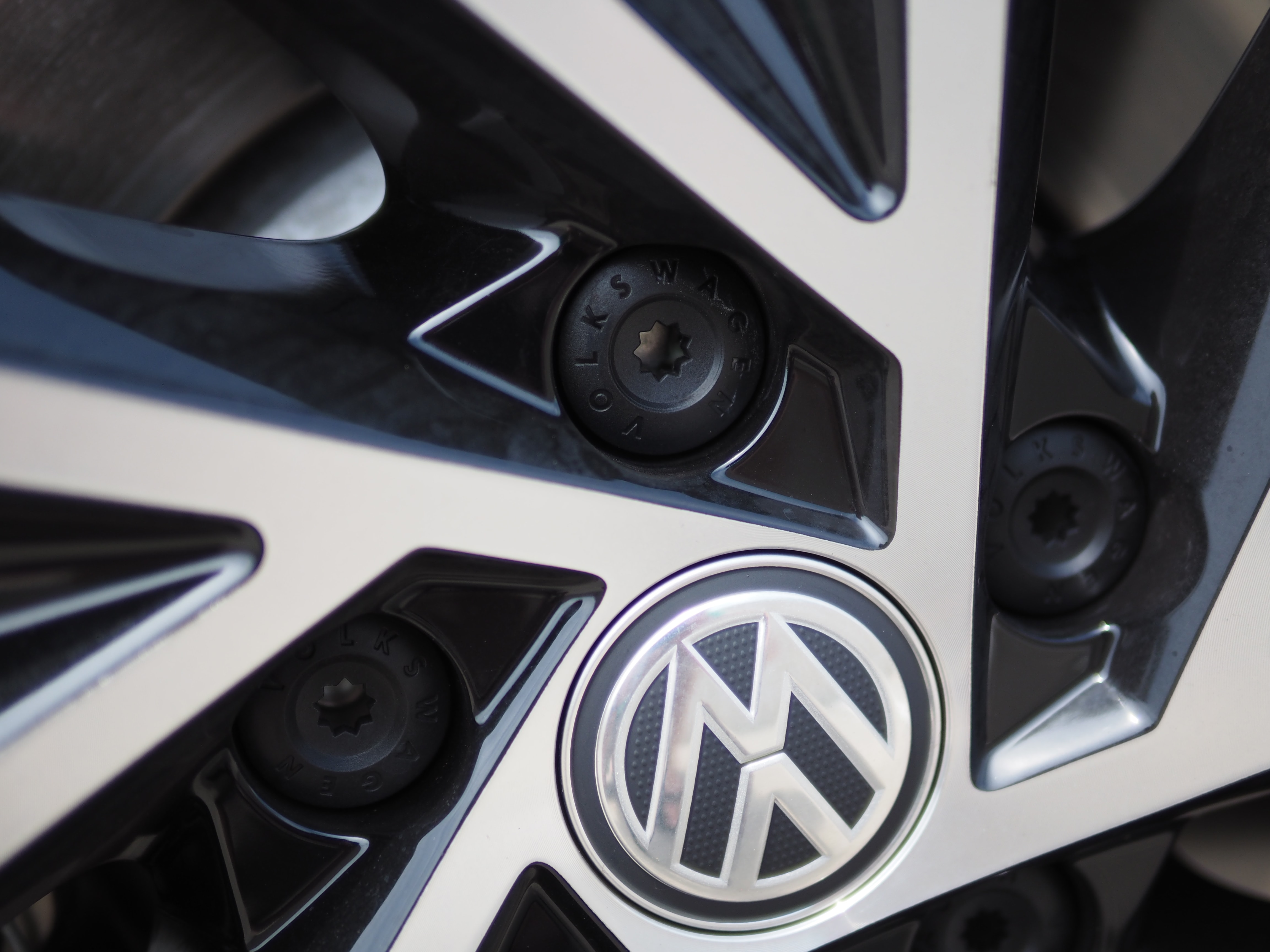
Looking to the Future
So, coming back around to the beginning, what do I do about my BMW?
When I drove the GTI, I was stupefied by how much car you got for the price. The one I drove was a bit over $30,000; it felt like it could have commanded a $40,000+ price tag.
The Golf R, by comparison, felt like it was every bit of its $40,680 MSRP. And in some ways, it felt like it should have been less. The lack of a sunroof is infuriating to me — at least give me the option, Volkswagen! While the R felt quite a bit more powerful than the GTI, it also felt like it was missing things for no discernible reason.
However.
Were I to buy a Golf R, I would miss the sunroof a lot. I’d miss it for easily six months of the year, if not more.
Should I buy a GTI, I’d miss the Golf R’s power… every time I drove my car. And, for the handful of snow storms Virginia gets each year, I’d miss the all wheel drive too.
Given the life changes my family has been through lately, we’re currently exploring the possibility of being a one-car family. Should we decide to get something new, I’m almost certainly going to get myself a Golf R.
One could make an argument the R is actually from a line that started with the original Audi TT, but now I’m splitting hairs. ↩
Unlike most cars I’ve driven, the Golf R actually remembers the drive mode you were in when you last drove the car. ↩
This week I joined Christa Mrgan, Dan Moren, and Mikah Sargent on Clockwise. On this episode, we discussed iMessage apps, Memoji, colorful iPhones, and AirPods.
Clockwise is the opposite of most tech podcasts I listen to: it moves very quickly. The clock is always ticking, after all. If you’ve never given it a try, you definitely should.
I had the pleasure of filling in on episode 200 of the wonderful (and spiritual sister podcast of ATP) Connected. Having just been married, Myke was a bit preoccupied, and Federico was following Justin Timberlake across Europe.
On this episode, John Voorhees, Stephen, and myself discussed the App Store’s tenth anniversary, the legacy of MobileMe, and the future of Apple hardware.
It was a pleasure filling in on one of my favorite tech podcasts; I’d love for you to have a listen.
Good news everyone! I’ve found the appropriate tool to fix the it’s-not-a-problem except-maybe-it-is MacBook keyboards!
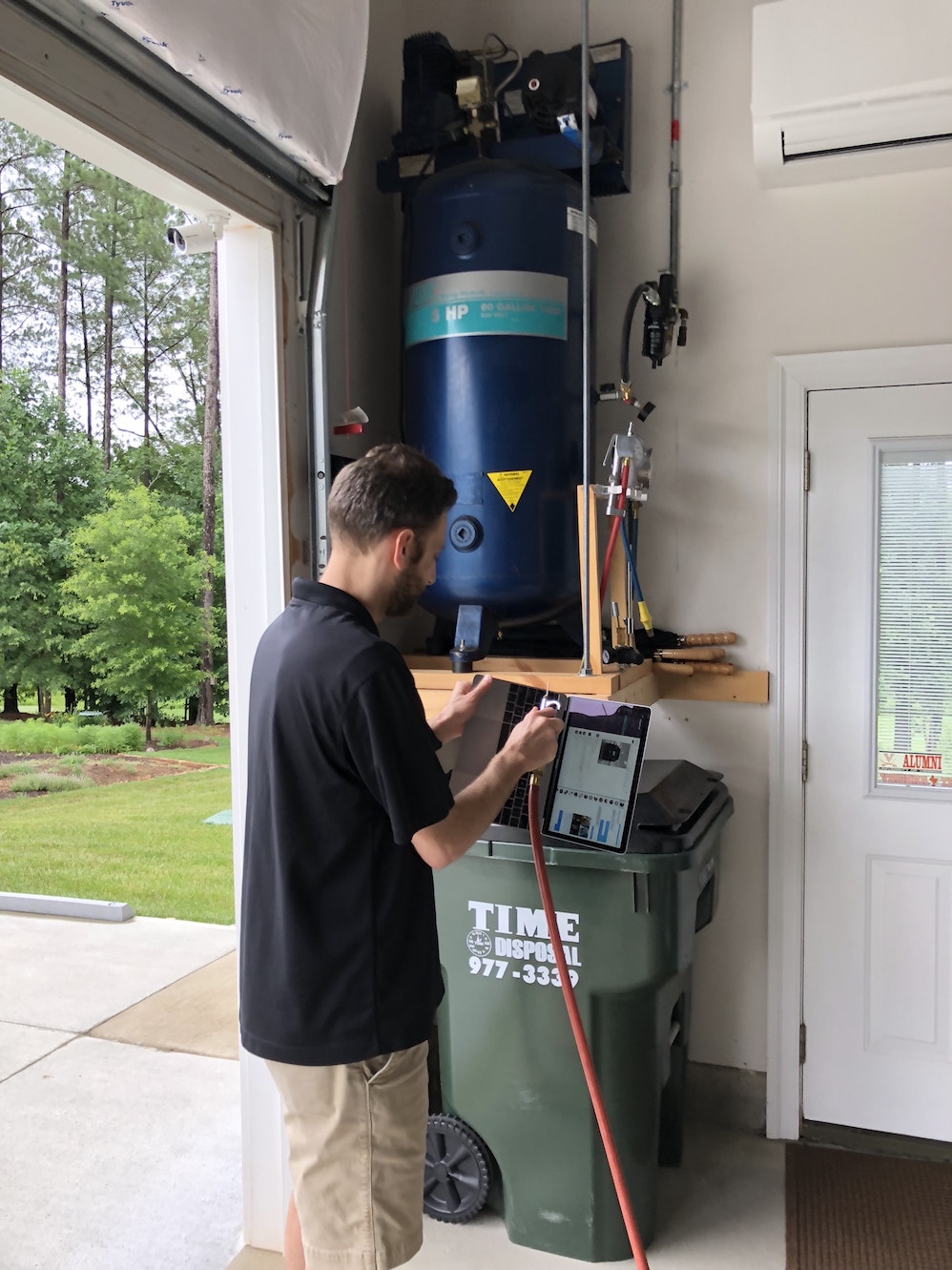
As we did last year, my pal _David Smith and myself decided to record a podcast within the WWDC podcast studio. The episode we recorded — entirely Dave’s idea — was ostensibly a behind-the-scenes about taking photographs of ATP Live and Relay Live. In actuality, it was an accidental Analog(ue) about getting yourself outside of your comfort zone.

The episode is one I’m very proud of. Dave opening up about his concerns about doing something scary and different was fascinating, and also relieving to hear. Turns out, I’m not the only one that gets scared. Plus, I almost never record with Dave, so it’s nice to have an excuse to do so. 😊
This past Tuesday, I woke up as I would any other Tuesday. I got ready for work like any other Tuesday. I went to work, met with my boss, and spoke two words that will dramatically change my life.
“I’m resigning.”
It’s funny, really. I can think of only a couple other pairs of words that have had similar impact on my life. Coincidentally, they were both spoken by Erin:
- “I do.”
- “I’m pregnant.”
Tuesday, I was the one speaking them, and I hope like hell I’m not making a huge mistake.
In around a month, I will no longer have a traditional job. I will be focusing my energy most especially on my family, with my two podcasts and side projects like Casey on Cars following behind. I do have some other things in the hopper, other than Casey on Cars, but I’m reticent to announce them before I know they’re ready.
I’m also entertaining other kinds of work. The impetus for this change is about being around for my family, so I don’t want to take on a 40 hour per week gig. However, if you need a hand with something interesting — especially if it involves either teaching or leveraging RxSwift — let me know.
Regardless, I’m super excited. My whole family is exceptionally, indescribably lucky to be able to attempt me going independent, no matter how long it lasts. I’m so excited to be able to shift the balance of my time from predominantly-work to predominantly-family. I’m so overjoyed to be able to spend time with Erin, Declan, and Mikaela.
In fact, I’m making this leap in no small part because Declan will be in school full-time in a few short years. Mikaela will follow shortly thereafter. There is no better time than now. If I can somehow make this work for the next five or so years, I’ll be overjoyed. If it goes even longer, well, I’ve hit the lottery.
Today, Myke and I released a very special episode of Analog(ue), which is focused on my decision, my thought process arriving there, and my future as an independent worker. Even if you don’t much care for Analog(ue), I’d love it if you gave this episode a shot. I’m really happy with it.
In many ways, this is the resolution of a story arc that is as old as the show. When we started this show, both Myke and I had “real” jobs. A couple episodes from now, we’ll both be independent workers.
I know that, on my death bed, I would regret not giving this a shot. I know that I would say “why did I work, rather than just trying to make it by myself”. I don’t want to make that mistake.
All in all, it’s a really odd thing. Tuesday will go down as either one of the best decisions I’ve ever made in my life, or one of the worst. Only time will tell. Sitting here now, where ignorance is Liss, I couldn’t be more excited or hopeful. I’m so pumped to be able to concentrate on all of the once-extracurriculars that I’ve wanted to get done, but haven’t been able to. With optimism pushing me forward, I can’t help but feel like this is the start of something amazing.
In my life, I’ve never been one to take risks. However, when I do, I’ve always been rewarded, regardless of the eventual outcome. The well-traveled road brings less surprise, but is paved with the regret of poorly trodden forks not taken.
I would be remiss to write this post without mentioning you. It is expressly because of the people that read this website — like you — and the people that listen to my podcasts — like you — and the people that watch my videos — like you — that I’m able to make this leap. Without you giving me your attention, my family would not be afforded this amazing opportunity.
And without the support of my family, and most especially my amazingly patient and brave wife Erin, none of this would be possible.
Sitting here now, I’m not planning a membership or Patreon or anything, but, do me a solid and keep an eye out, would you? And do be sure to use the ATP and Analog(ue) coupon codes. Or get a Relay membership. Hell, do all of the above! But more than anything else, wish me luck.
This week, I’m the guest on the Swift Teacher Podcast. On this episode, Brian and I discuss my history as a developer, my toolchain at work, the transition from C++ → C# → Swift, and, of course, RxSwift.
I had a lot of fun on this episode, as the show is not the kind of show I am usually asked to participate in. Definitely check it out, as well as the other episodes. I particularly liked episode #3, with the founders of Workflow.
I occasionally get asked for recommendations for good food in the Richmond, Virginia area. This is a big ask, because Richmond has a lot of really good food options, which seem to always be changing.
This is my list. There are many like it, but this one is mine.
I’ll cover Richmond proper, as well as the yuppie-central West End / Short Pump area. I don’t often stray south of the river, so, you’ll have to figure that out yourself.
The below is not a definitive list. There are a zillion restaurants in Richmond that I haven’t tried yet. These are some that I endorse, but there are many many others that are just as good, if not better.
Additionally, I’ll probably quietly update it over time, as I find new places, old ones close, etc. This is going to be a living resource.
- Breakfast
- Downtown
- Early Bird Biscuit Company – Yelp
Really great and varied biscuits, naturally. The line is long, and they do eventually sell out. Get there as early as you can muster. - Millie’s – Yelp
Perfect hangover food. Basically a mess of eggs and other sundries. I fancy the Castro’s Mess. Very small, so it also falls victim to lines.
- Early Bird Biscuit Company – Yelp
- West End
- Rise Biscuits and Donuts – Yelp
Delicious biscuits and donuts. Go figure. Try the hashpuppies. - Duck Donuts – Yelp
An Outer Banks staple, you choose your toppings to make ridiculous concoctions like French Toast, or Maple Bacon. Go nuts. - Cupertino’s – Yelp
This half-Jew from New York approves of these bagels. 'Nuff said. You could also try the chicken salad club if you get there over lunch.
- Rise Biscuits and Donuts – Yelp
- Downtown
- Lunch/Dinner
- Downtown
- Kuba Kuba – Yelp
The lines are long and the kitchen is open. If you go, you’ll need to shower and do laundry once you leave. But my word, the food is great. - Kitchen 64 – Yelp
Hilariously large portions, and near-ish some really great museums. If you’re in this area, also check out Maymont Park. - Sticky Rice – Yelp
Inventive sushi. Get the bucket of tots. - Citizen Burger Bar – Yelp
Truly delicious burgers, as artisinal and ridiculous as you’d like them. - Maya – Yelp
Upscale Mexican. Get the queso fundido to start, and you’ll think things cannot possibly get any better. Then get the chipotle bourbon tacos, medium rare, realize you were wrong, and expect to dream about the tacos for the rest of your life. - Can Can Brasserie – Yelp
I’ve never been, but I’ve heard universally phenomenal things about this cute French restaurant. - Boathouse at Rocketts Landing – Yelp
An impeccable location right on the river, with food that’s almost as good as the view. However, you’ll pay for it, quite literally. - Legend Brewing Company – Yelp
The food is okay, but being just off the river, opposite the city, the view is tremendous. Go just before sundown and sit on the deck; you’ll see a killer view of the city and river as the sun sets.
- Kuba Kuba – Yelp
- West End
- Kuba Kuba Dos – Yelp
Like Kuba Kuba above, but without the lines, and without the open kitchen. - Two Guys Pizza – Yelp
The best pizza in town. They sell by the slice, and you need to fold them to eat them. Between Two Guys and Cupertino’s, this former New Yorker can call Richmond home. - Hutch – Yelp
Get the prime rib poutine if it’s available; if it isn’t, ask. - Burger Bach – Yelp
Pronounced “batch”, not “bock”, you can get all sorts of delicious, if expensive, burgers. On the down side, the fries cost extra. On the plus side, you can choose from many different dipping sauces to have with them. - Capital Ale House – Yelp
The food is good but not great. The beer selection, if that’s your kind of thing, is tremendous. They have something like 50 taps and a shedload of bottles.
- Kuba Kuba Dos – Yelp
- Also Consider
- Q Barbeque – Yelp
North of town, my favorite BBQ in Richmond. Get the ribs.
- Q Barbeque – Yelp
- Downtown
I always prefer to receive bad news first, so here goes: there is not a new design this year for ATP shirts.
The good news, however, is copious:
- The wildly popular
//////ATPdesign returns for another year - We have more than just T-shirts this year:
- Black and Coal embroidered hats
- Embroidered polo shirts, if you have a real job, like me!
- Embroidered zipped hoodies
- Pins! You can now get the logo as a beautiful, multicolored enamel pin!
- The pins are available for purchase right now, and if you act fast, will
ship soon.
- If you want your pin before WWDC, you should absolutely buy now, as quantities are limited for this first run. (We’ll get more once these sell out though)
You can browse all of these products at our store over at Cotton Bureau.
We’ve also got some other interesting and fun things in the works, so keep an eye out for more products in the future.
As always, buying merch benefits the three of us directly, and we deeply appreciate whatever money you’re willing to part with to show your support.
Plus, all apparel comes with a guarantee of a high five from me if I see you wearing it. Which, let’s be honest, is worth the price.
Nobody seems to be able to agree on the exact definition of a millennial.
Having been born in the early 1980s, by most — but not all — definitions, I am a millenial. Nevertheless, I find myself with a leg in both worlds. I remember a time before the internet. I remember paying for long distance. I remember having to buy a calling card to call my long-distance high school girlfriend.
Unlike your stereotypical millenial, however, I could not wait to get my driver’s license.
In Connecticut, where I was living at the time, you could get your permit at sixteen. Which I did. On my actual birthday. To get your license, you needed to either enroll in driver’s ed and wait 4.5 months, or eschew formal driver’s education and wait six months. At that point, you could take your driving test at the local DMV. My high school didn’t offer driver’s ed, and I did not opt for the program run by Sears (yes, seriously).
Thus, at around sixteen years and seven months, I scored a driver’s license. I was finally on the road to adulthood. I was finally able to exert some amount of control over my own life.
One evening, shortly after getting my license, I returned home from a friend’s house. I came home at a reasonable hour, and approached my driveway. Our house had a very steep drive that would cause slight concern for your average family sedan, and great concern for an average sports car.
On this particular evening, sitting at the bottom of the drive, in the dark, was an even darker, black, Ferrari F355. As soon as I saw it, I knew who was visiting.
My parents had some friends that had really gone places. We all lived in the generally unremarkable small town of New Fairfield, Connecticut. Despite a population of around 10,000 people, we had a few notable residents. Until his unfortunate passing, my parents were quite close with the man who coined “Pepsi Generation”, for example. But surprisingly, it wasn’t his Ferrari — he preferred Jaguars. The Ferrari instead belonged to Jimmy Galante.
Jimmy was a larger-than-life fellow. He owned Automated Waste Disposal, a trash collection service in the neighboring “big city” of Danbury. Being of Italian descent, and in trash disposal, in a town that neighbored New York state and a mere hour from the outskirts of New York City, we always chuckled about Mr. Galante. But we never really suspected anything.
Nonetheless, I came waltzing in, as only a cocksure sixteen year old can, and told Jimmy I liked his car. Without batting an eye, he asked me if I wanted to go for a ride.
In my 36 years, this is the only time I’ve ever been offered a ride in a Ferrari. You bet your ass I said “yeah, sure!”.
The next thing I knew, I was on the road in Jimmy’s Ferrari. Our neighborhood was just off a mostly-straight, nearly two mile stretch of road. Jimmy took me down that road, mostly behaving himself. Despite it being a rather pedestrian journey, nothing is pedestrian when you’re in a quarter million dollar Italian sports car.
We made chitchat, as much as a sixteen year old can with an extremely successful business mogul who owns a Ferrari. I remember being at the Galante’s not too long before, and noticing that in their garage, Mrs. Galante had the enviable burden of choosing between a Jeep Grand Cherokee, a Jaguar XK8 convertible, and an E46 BMW M3. Note that this is just Roseanne; Jimmy had his own stable as well. And a race team to boot.
As we chatted, he asked me about taking my test, and whether or not I knew how to drive a stick. I proudly told him I had in fact taken my driver’s test in my Dad’s Saturn SL2, which was a five speed.
At the end of the road, Jimmy turned the car around, pointing it back toward my house. But just as he completed his turn, he stopped dead in the middle of this not-seldom-traveled road. He opened his door, unbuckled his seatbelt, and stepped out of the car. As he did so, I heard him say something over his shoulder, but I only caught two words. It was the two words that matter.
Your turn.
With considerable trepidation, I climbed out of the passenger seat. With a quickness, I jumped into the driver’s seat. I buckled up, adjusted the seat a bit, depressed the clutch, and slotted the gated shifter into first gear. Immediately, I noticed that the pedals in the Saturn were arranged like country houses to the Ferrari’s row houses. There must have been space between the pedals, but it was indistinguishible.
I very gingerly let off the clutch, opening the taps of the Ferrari’s V8 ever-so-slightly. I was quite lucky, as I was able to successfully launch the car with nary a bog nor a chirp of the wheels.
Before long, I had executed shifts into second, and third, and was cruising down this 45 MPH road. I felt like a million bucks. We continued to talk on the cruise home, with my responses coming late and disjoint; I was quite distracted. Eventually we had a beat or two of lightly uncomfortable silence. It was then that Jimmy asked a question, which took me a moment to process:
How fast do you think we’re going?
Having only been driving for a few weeks at this point, I wasn’t sure, but I was confident I was keeping it to within ~10 MPH of the limit. I stammered, with no confidence, “Not too fast, I don’t think…?”, and then looked to verify my assertion.
I got distracted by the prancing horse shown in the speedometer.
Once I regained my composure, I looked at the speedometer more closely. My speed was indicated to be 70 MPH. In a 45.
No part of me could believe that. I felt like I was crawling.
Turns out, Ferraris handle their speed better than Saturns do.
We made it back safely, with an increased awareness of my speed through the remainder of the trip. Jimmy was a great sport about it all. He knew that 10 minutes of his time would lead to a memory that I’d cherish for a lifetime.
He was right. Here I am, literally twenty years later, retelling it, publicly.
It was a hell of a night. And a hell of a kind gesture from a man who owed me precisely nothing.
Fast forward a few years, and I’m in college. Suddenly, I hear the name Galante being talked about again. Which is weird, because I wasn’t at UCONN or some local school. I was nearly 600 miles away in southwest Virginia. Yet, I was hearing the name of not only Jimmy, but his son, AJ.
As it turns out, AJ — then a senior in high school — was now the general manager of the Danbury Trashers, a minor league hockey team that Jimmy had just purchased. This was quite the amusing story to many, including ESPN; it briefly made national news.
Nonetheless, I didn’t hear much more about Jimmy for a couple years. Until the [is-it-really-though?] unexpected happened: Jimmy was indicted for running his businesses dirty, in association with the Genovese crime family. He was charged with, among other things, racketeering.
Jimmy ended up serving some time in prison. While that isn’t surprising, it is a little odd for me to square that Jimmy with the one that let me take his Ferrari for a spin. In the dead of night.
All of these memories came flooding back to me today because my mother pointed me to an article chronicling the rise and fall of the Danbury Trashers. It’s a fun and fascinating read, but it’s doubly weird for me, as I knew at least some of the players. Beyond the Galantes, a dear family friend of ours, a woman my age, spent some time working for Jimmy and the Trashers when they were still around.
What an odd web life weaves.
Regardless, if you want to hear about a shrewd businessman who made some parenting choices many would consider suspect, read Rich Cohen’s article. But do remember the family friend, who did a punk kid a solid, just for the hell of it.
And if you’d like to hear me retell it verbally, there’s always Neutral.